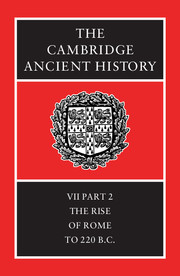Book contents
- Frontmatter
- 1 The Sources for Early Roman History
- 2 Archaic Rome Between Latium and Etruria
- 3 The origins of Rome
- 4 Rome in the fifth century I: the social and economic framework
- 5 Rome in the fifth century II: the citizen community
- 6 Rome and Latium to 390 B.C.
- 7 The recovery of Rome
- 8 The conquest of Italy
- 9 Rome and Italy in the early third century
- 10 Pyrrhus
- 11 Carthage and Rome
- 12 Religion in Republican Rome
- Appendix
- Chronological Table
- BIBLIOGRAPHY
- Index
- Fig. 50:The city of Rome in the early third century b.c.
- Map 11: The western Mediterranean in the third century
- References
8 - The conquest of Italy
Published online by Cambridge University Press: 28 March 2008
- Frontmatter
- 1 The Sources for Early Roman History
- 2 Archaic Rome Between Latium and Etruria
- 3 The origins of Rome
- 4 Rome in the fifth century I: the social and economic framework
- 5 Rome in the fifth century II: the citizen community
- 6 Rome and Latium to 390 B.C.
- 7 The recovery of Rome
- 8 The conquest of Italy
- 9 Rome and Italy in the early third century
- 10 Pyrrhus
- 11 Carthage and Rome
- 12 Religion in Republican Rome
- Appendix
- Chronological Table
- BIBLIOGRAPHY
- Index
- Fig. 50:The city of Rome in the early third century b.c.
- Map 11: The western Mediterranean in the third century
- References
Summary
ROME'S FIRST STRUGGLE WITH THE SAMNITES, THE DEFEAT OF THE LATINS AND THE FORMATION OF THE ROMAN COMMONWEALTH
The emergence of the nobility and the competition for honours among its individual members, described in the previous chapter, were directly related to the development of Roman imperialism. The great political figures who dominated public life in the second half of the fourth century B.C. initiated and directed a policy of military conquest which in the space of little more than half a century brought all of peninsular Italy under Rome's control. This process was dominated by the struggle between Rome and the Samnites, which began in 343 B.C.
The Samnites were a powerful federation of tribes who occupied a large area of the southern central Appennines. Samnium was a land-locked region, roughly rectangular in shape, which stretched diagonally from the river Sagrus (Sangro) in the north-west to a point beyond the Aufidus (Ofanto) in the south-east. On its north-eastern side it was separated from the coast by the lands of the Frentani and Apuli, and on the south-western side by those of the Volsci, Sidicini, Aurunci, Campani and Alfaterni. The precise line of the frontier in 343 B.C. cannot be drawn with any certainty; its probable course is most easily indicated on a map (see Map 5).
The area defined by these conjectural limits measures some 12,500 km. Both in antiquity and in more recent times Samnium seems to have been densely populated by comparison with other rural areas of peninsular Italy. On the basis of modern calculations the total population of Samnium in 343 B.C. can be estimated at around 450,000 persons.
- Type
- Chapter
- Information
- The Cambridge Ancient History , pp. 351 - 419Publisher: Cambridge University PressPrint publication year: 1990
References
- 41
- Cited by



